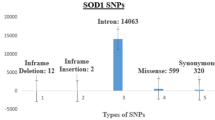Abstract
MicroRNAs (miRNAs) are small regulatory RNAs that modulate the expression of approximately half of all human genes. Small changes in miRNA expression have been associated with several psychiatric and neurological disorders, but whether the polymorphisms in genes involved in the processing of miRNAs into maturity influence the susceptibility of a person to schizophrenia (SZ) has not yet been elucidated. In this study, we investigated the association between SZ risk and single-nucleotide polymorphisms (SNPs) in microRNA machinery genes. We assessed the associations between SZ as a risk and six potentially functional SNPs from five miRNA processing genes (DROSHA, DGCR8, DICER, AGO1, and GEMIN4) in a case-control study of 256 Chinese SZ patients and 252 frequency-matched (age, gender, and ethnicity) controls. All the SNPs (rs10719, rs3757, rs3742330, rs636832, rs7813, and rs3744741) were genotyped by high resolution melting method. We found that two SNPs in the DGCR8 and DICER gene were significantly associated with the altered SZ risk. The genotype or allele frequency of rs3742330 in DICER was significantly different in patients and controls. Moreover, the recessive model of rs3757 in DGCR8 (AA vs. GA/GG) exhibited a significantly increased risk with an odds ratio (OR) of 3.73 [95 % confidence interval (CI), 1.03–13.52, P = 0.032]; the dominant model of rs3742330 in DICER (AA vs. AG/GG) exhibited a significantly increased risk with OR of 1.49 (95 % CI, 1.04–2.13; P = 0.028). Other SNPs and the haplotype of GEMIN4 (rs3744741 and rs7813) did not show any association with SZ. Our results suggested that the specific genetic variants in microRNA machinery genes may affect SZ susceptibility.
Similar content being viewed by others
References
Beveridge NJ, Gardiner E, Carroll AP, Tooney PA, Cairns MJ (2010) Schizophrenia is associated with an increase in cortical microRNA biogenesis. Mol Psychiatry 15:1176–1189
Bushati N, Cohen SM (2007) MicroRNA functions. Annu Rev Cell Dev Biol 23:175–205
Cheng LC, Pastrana E, Tavazoie M, Doetsch F (2009) miR-124 regulates adult neurogenesis in the subventricular zone stem cell niche. Nat Neurosci 12:399–408
Clague J, Lippman SM, Yang H et al (2010) Genetic variation in microRNA genes and risk of oral premalignant lesions. Mol Carcinog 49:183–189
Davis TH, Cuellar TL, Koch SM et al (2008) Conditional loss of Dicer disrupts cellular and tissue morphogenesis in the cortex and hippocampus. J Neurosci 28:4322–4330
Freedman R (2003) Schizophrenia. N Engl J Med 349:1738–1749
Friedman RC, Farh KK, Burge CB, Bartel DP (2009) Most mammalian mRNAs are conserved targets of microRNAs. Genome Res 19:92–105
Hansen T, Olsen L, Lindow M et al (2007) Brain expressed microRNAs implicated in schizophrenia etiology. PLoS One 2:e873
Horikawa Y, Wood CG, Yang H et al (2008) Single nucleotide polymorphisms of microRNA machinery genes modify the risk of renal cell carcinoma. Clin Cancer Res 14:7956–7962
Kim JS, Choi YY, Jin G et al (2010) Association of a common AGO1 variant with lung cancer risk: a two-stage case-control study. Mol Carcinog 49:913–921
Lin J, Horikawa Y, Tamboli P, Clague J, Wood CG, Wu X (2010) Genetic variations in microRNA-related genes are associated with survival and recurrence in patients with renal cell carcinoma. Carcinogenesis 31:1805–1812
Liu J, Carmell MA, Rivas FV et al (2004) Argonaute2 is the catalytic engine of mammalian RNAi. Science 305:1437–1441
Miller BH, Wahlestedt C (2010) MicroRNA dysregulation in psychiatric disease. Brain Res 1338:89–99
Santarelli DM, Beveridge NJ, Tooney PA, Cairns MJ (2011) Upregulation of dicer and microRNA expression in the dorsolateral prefrontal cortex Brodmann area 46 in schizophrenia. Biol Psychiatry 69:180–187
Schaefer A, O'Carroll D, Tan CL et al (2007) Cerebellar neurodegeneration in the absence of microRNAs. J Exp Med 204:1553–1558
Sethupathy P, Collins FS (2008) MicroRNA target site polymorphisms and human disease. Trends Genet 24:489–497
Stark KL, Xu B, Bagchi A et al (2008) Altered brain microRNA biogenesis contributes to phenotypic deficits in a 22q11-deletion mouse model. Nat Genet 40:751–760
Tabares-Seisdedos R, Rubenstein JL (2009) Chromosome 8p as a potential hub for developmental neuropsychiatric disorders: implications for schizophrenia, autism and cancer. Mol Psychiatry 14:563–589
Wang P, Dai M, Xuan W et al (2006) SNP Function Portal: a web database for exploring the function implication of SNP alleles. Bioinformatics 22(14):e523–e529
Wayman GA, Davare M, Ando H et al (2008) An activity-regulated microRNA controls dendritic plasticity by down-regulating p250GAP. Proc Natl Acad Sci USA 105:9093–9098
Xu B, Karayiorgou M, Gogos JA (2010) MicroRNAs in psychiatric and neurodevelopmental disorders. Brain Res 1338:78–88
Yang H, Dinney CP, Ye Y, Zhu Y, Grossman HB, Wu X (2008) Evaluation of genetic variants in microRNA-related genes and risk of bladder cancer. Cancer Res 68:2530–2537
Ye Y, Wang KK, Gu J et al (2008) Genetic variations in microRNA-related genes are novel susceptibility loci for esophageal cancer risk. Cancer Prev Res 1:460–469
Zhu Y, Kalbfleisch T, Brennan MD et al (2009) A microRNA gene is hosted in an intron of a schizophrenia-susceptibility gene. Schizophr Res 109:86–89
Funding
This work was supported by grants from National Natural Science Foundation of China (grant number 81101326).
Conflict of Interest
The authors declared that they have no competing interests.
Author information
Authors and Affiliations
Corresponding authors
Additional information
Yi Zhou and Jun Wang have contributed equally to this work.
Electronic Supplementary Material
Below is the link to the electronic supplementary material.
ESM 1
(DOC 38 kb)
Rights and permissions
About this article
Cite this article
Zhou, Y., Wang, J., Lu, X. et al. Evaluation of Six SNPs of MicroRNA Machinery Genes and Risk of Schizophrenia. J Mol Neurosci 49, 594–599 (2013). https://doi.org/10.1007/s12031-012-9887-1
Received:
Accepted:
Published:
Issue Date:
DOI: https://doi.org/10.1007/s12031-012-9887-1




